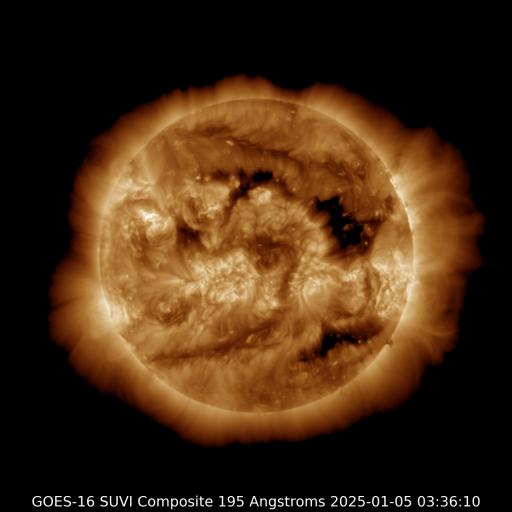Viewing archive of Wednesday, 28 December 2011
Geophysical report
Prepared by the NOAA © SWPC and processed by SpaceWeatherLive.com
Joint USAF/NOAA Solar and Geophysical Activity Summary
SGAS Number 362 Issued at 0245Z on 28 Dec 2011 This report is compiled from data received at SWO on 27 DecA. Energetic Events
Begin Max End Rgn Loc Xray Op 245MHz 10cm Sweep 0209 0209 0209 110 0411 0422 0431 1386 S17E32 C8.9 1f 170 5100 0609 0609 0609 180 0906 0906 0906 200 1401 1401 1401 110 1445 1445 1446 1000 1523 1523 1523 100
B. Proton Events
C. Geomagnetic Activity Summary
D. Stratwarm
E. Daily Indices: (real-time preliminary/estimated values)
10 cm 140 SSN 126 Afr/Ap 002/001 X-ray Background B5.5 Daily Proton Fluence (flux accumulation over 24 hrs) GT 1 MeV 3.7e+05 GT 10 MeV 1.6e+04 p/(cm2-ster-day) (GOES-13 satellite synchronous orbit W75 degrees) Daily Electron Fluence GT 2 MeV 1.00e+06 e/(cm2-ster-day) (GOES-13 satellite synchronous orbit W75 degrees) 3 Hour K-indices Boulder 0 0 0 0 1 2 2 1 Planetary 0 0 0 0 0 0 0 1
F. Comments
None.
All times in UTC
Current data suggests there is a moderate possibility for aurora to appear at the following high latitude regions in the near future
Fairbanks, AKCurrent data suggests there is a slight possibility for aurora to appear at the following high latitude regions in the near future
Edmonton, AB, Gillam, MB, Whitehorse, YT, Yellowknife, NTAnchorage, AK, Juneau, AK, Utqiagvik, AK
Latest news
Latest forum messages
Support SpaceWeatherLive.com!
A lot of people come to SpaceWeatherLive to follow the Sun's activity or if there is aurora to be seen, but with more traffic comes higher server costs. Consider a donation if you enjoy SpaceWeatherLive so we can keep the website online!

Latest alerts
Saturday, 15 March 2025
13:48 UTC - Hemispheric Power Index
The OVATION model predicts the Hemispheric Power Index to reach 52GW at 14:31 UTC
Friday, 14 March 2025
22:39 UTC - Solar flare
Moderate M1.16 flare
22:24 UTC - Radio Blackout
Minor R1 radio blackout in progress (≥M1 - current: M1.16)
10:55 UTC - Coronal hole
A southern hemisphere coronal hole is facing Earth. Enhanced solar wind could arrive in ~3 days
Space weather facts
| Last X-flare | 2025/02/23 | X2.0 |
| Last M-flare | 2025/03/14 | M1.1 |
| Last geomagnetic storm | 2025/03/14 | Kp6- (G2) |
| Spotless days | |
|---|---|
| Last spotless day | 2022/06/08 |
| Monthly mean Sunspot Number | |
|---|---|
| February 2025 | 154.6 +17.6 |
| March 2025 | 125.9 -28.7 |
| Last 30 days | 139.6 -15 |




